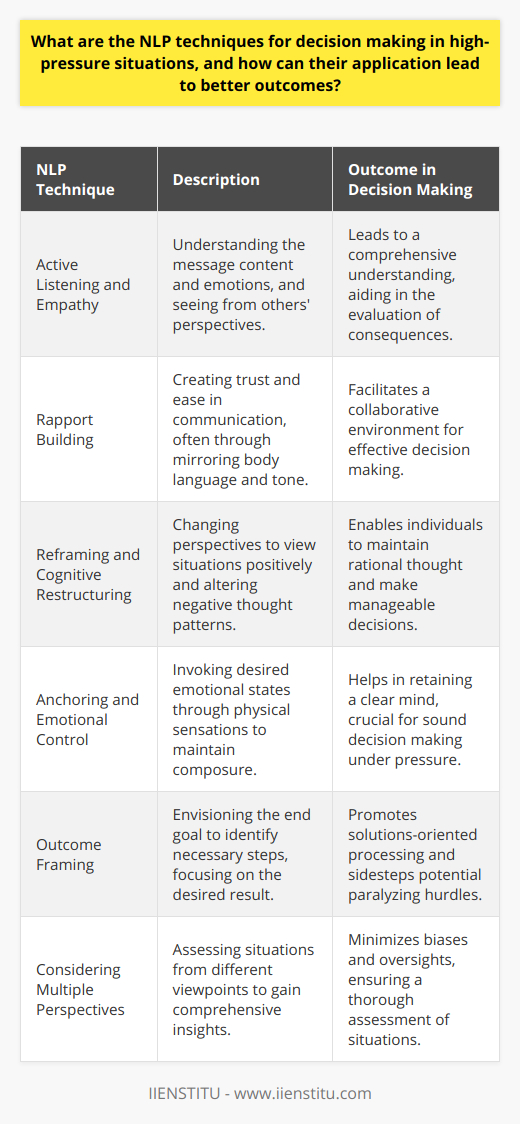
Mastering the art of communication is key to success in any field. And while some people seem to be born communicators, the rest of us can learn these skills with a bit of practice. Luckily, there are now many effective techniques that can help us to improve our communication skills. Here are 10 of the most powerful NLP techniques that will make you a better communicator:
10 NLP Techniques for Better Communication
In today's world, good communication skills are essential for success. Whether you're a doctor or a lawyer, a teacher or a salesperson, communicating clearly and effectively is crucial. The good news is that, while some people seem to be born communicators, the rest of us can learn these skills with a bit of practice. There are now many effective techniques that can help us to improve our communication skills.
For example, active listening is a skill that can be learned and practiced, and it's essential for effective communication. When we actively listen, we make an effort to understand what the other person is saying, not just what we think they're saying.
We also work to non-verbally communicate our interests and understanding through things like eye contact and body language. With a bit of effort, everyone can learn how to communicate effectively. And when we do, we open up a whole world of opportunities.
1. Anchoring
The idea behind anchoring is simple: by associating positive emotions with a specific stimulus, you can quickly access those emotions when you need them most. For example, you might anchor the feeling of confidence to the word "Yes!" By doing this, you can remind yourself of that feeling of confidence whenever you need it.
Anchoring is a powerful tool because it can help you overcome negative emotions and access positive ones more easily. In addition, anchoring can be used in any situation where you need a boost of positive emotion.
So, whether you're facing a challenging problem at work or want to feel happier in general, anchoring can help you reach your goal.
2. Chunking
In today's fast-paced world, it's more important than ever to communicate clearly and concisely. One way to do this is to chunk information. This means breaking down news into smaller, more manageable pieces.
When we chunk information, we make it easier to process and remember. This is especially useful when we need to communicate complex ideas. By chunking information, we can make sure that our audience understands the main points of our message.
How To Choose The Best Personal Development Course For Your Needs
İnspiring Films About Life Coaching And Personal Transformation
Additionally, chunking can help us to remember information more effectively. So next time you need to communicate a complex idea, try chunking the information to make it more understandable and memorable.
3. Reframing
Our perception of any given situation is subjective, filtered through our own biases and past experiences. This isn't necessarily a bad thing – after all, our perspectives are what make us who we are. However, there are times when it can help to step outside of our philosophy and view a situation from another angle.
This process is known as reframing, and it can be a powerful tool for managing our emotions and overcoming challenges. For example, if we reframe a negative experience as an opportunity to learn and grow, we can approach it with greater clarity and purpose.
Similarly, if we reframe a difficult task as an exciting challenge, we may be more motivated to complete it. By changing how we perceive an experience or situation, we can open ourselves up to new possibilities and discover hidden strengths. So the next time you're facing a challenging problem, try reframing it – you may be surprised at what you're capable of.
4. Modelling
One of the most effective ways to improve our communication skills is to model the behavior of successful communicators. By observing and imitating the strategies used by people we admire, we can learn to communicate more effectively ourselves.
This process begins with identifying the people whose communication style we would like to emulate. Once we have identified these role models, we can then start to observe and imitate their behavior.
As we follow their communication strategies, we can begin to adopt them as our own. Over time, this process will help us develop our unique communication style. By modeling the behavior of successful communicators, we can learn to communicate more effectively ourselves.
5. Mirroring
Mirroring is a technique that can build rapport and make another person feel more comfortable. To reflect someone, match their body language, voice tone, and words. For example, if they speak quietly, you would whisper as well. If they are crossing their arms, you will betray your arms.
This technique works because it creates a sense of mutual understanding and makes the other person feel as though they are being heard and respected. Additionally, mirroring can help to build trust and fondness, as it subconsciously signals that we are similar to the other person.
All in all, mirroring is a simple but powerful tool that can improve communication and create a strong connection with others.
6. Pacing
Good communication is essential for building strong relationships, both personal and professional. A critical aspect of effective communication is pacing, which involves matching the other person's communication speed, intensity, and rhythm. Pacing can help you to build rapport and keep the conversation flowing smoothly. It can also be used to de-escalate conflict, as it can help calm down an agitated individual.
When pacing, it is essential to be aware of the other person's nonverbal cues, as these can give you clues about how they are feeling and what they are thinking. By being attuned to these cues, you can ensure that your pacing is adequate and that you are building rapport with the other person.
7. Cold reading
Cold reading is a technique often used by psychologists and counselors. It involves making accurate guesses about someone's personality or situation based on their nonverbal cues. For example, a cold reader might note that a person is fidgeting and conclude that they are nervous or anxious. Or, they might observe that a person is avoiding eye contact and judging their level of trustworthiness.
While cold reading can be helpful in some situations, it is essential to remember that it is not always accurate.
For example, people can have different reasons for fidgeting or avoiding eye contact, so taking these cues with a grain of salt is essential. In addition, cold reading can sometimes manipulate or mislead people, so it is necessary to be aware of this potential downside before using this technique.
8. Active listening
Active listening is a critical communication skill that involves paying attention to what the other person is saying verbally and non-verbally. Listening is more than just hearing the words that are spoken. It also involves understanding the message that is being conveyed and the feelings and emotions underlying the statement.
To truly engage in active listening, it is also essential to reflect on what you've heard to ensure that you've understood it correctly. This can be done by summarizing what the other person has said or asking clarifying questions.
Active listening requires patience and practice, but it is an essential skill for effective communication.
9. Questioning
Asking questions is a great way to show interest in the other person and keep the conversation going. But be sure to ask open-ended questions that can't be answered with a simple "yes" or "no." For example, instead of asking, "Do you like to read?" you could say, "What kind of books do you like to read?".
This gives the other person a chance to share their interests and gives you something to talk about. Similarly, instead of asking, "Are you going to the party on Saturday?" you could say, "I hear there's a party on Saturday.
Are you planning on going?". This shows that you are interested in the event and opens up the possibility for further conversation. So next time you're stuck for something to say, try asking a question. Just be sure to make it an open-ended one!
10. Body language
The way we carry ourselves conveys a wealth of information to the world, even when we're not speaking. From the way we walk into a room to how we hold our heads, our body language constantly sends signals about our thoughts and emotions. This is why it's so important to be aware of the message our posture, gestures, and facial expressions are conveying.
By paying attention to our body language, we can ensure that we're sending the message we want to send. We can appear confident and self-assured, even when we don't feel that way inside. We can convey our interest and enthusiasm or show that we're approachable and friendly. In short, paying attention to our body language can help us create the impression we want to make.
If you want to use these principles in your own sales interactions or learn more about how to read and understand people's body language, we have the perfect solution for you. Join our upcoming Neuro-Linguistic Programming (NLP) course and become a master of human communication.
During this eight-week online course, you will learn all about the different ways to use neuroscience principles to improve your personal and professional relationships. With this new knowledge under your belt, there is no telling what heights of success you will reach. So register today and start learning how to use the brain's power to get ahead in life!
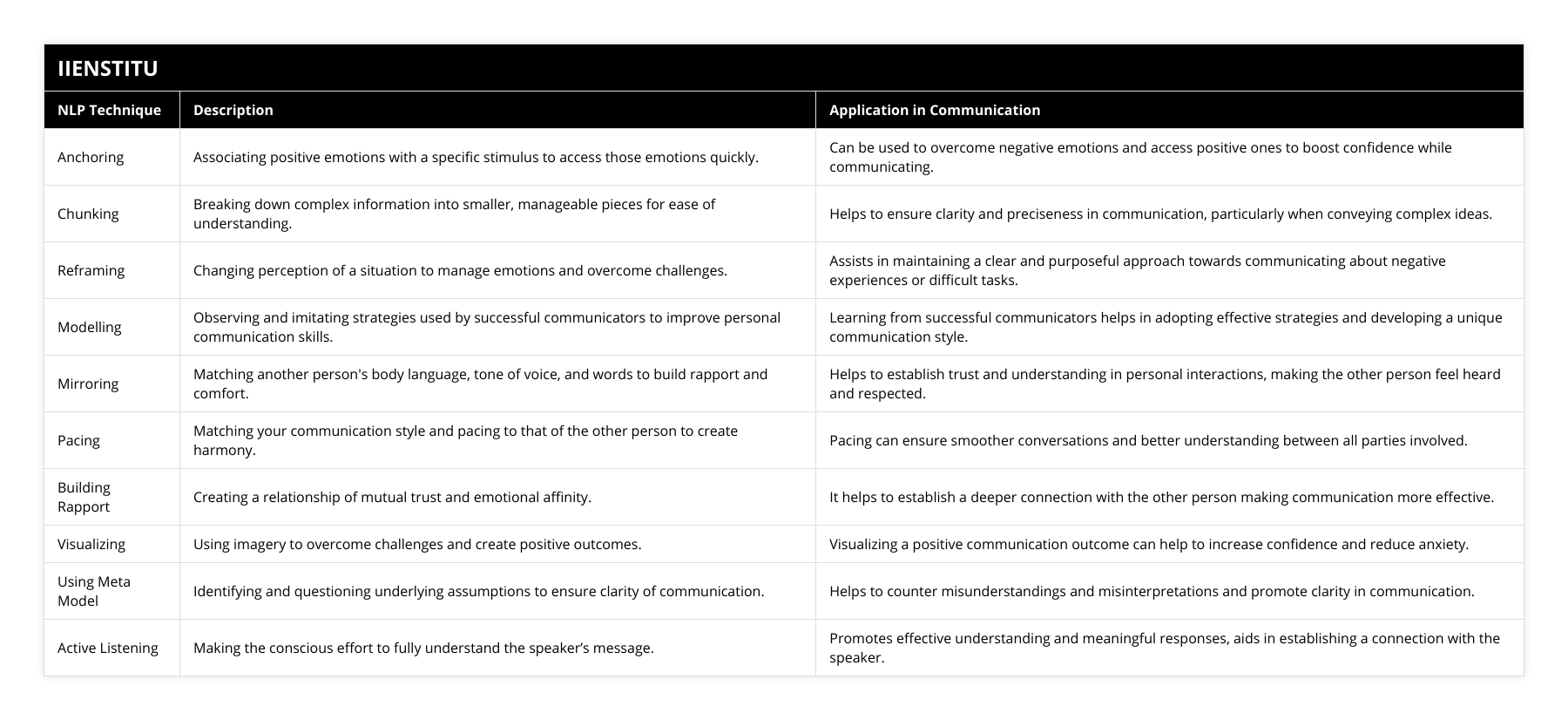
Frequently Asked Questions
How can NLP techniques make you a better communicator?
There are many ways that NLP techniques can improve your communication skills. For example, NLP can help you to understand the body language and nonverbal communication of others, as well as improve your own ability to use these channels effectively. In addition, NLP can also help you to understand and manage your own emotions, as well as those of others. By understanding and controlling your emotions better, you will be able to communicate more effectively in any situation. Finally, NLP also teaches principles and techniques for effective listening, which is a critical skill for any good communicator. By improving your listening skills, you will be able to better understand the needs and wants of others, and respond in a way that is more likely to get
What are some of the benefits of using NLP techniques when communicating with others?
There are many benefits to using NLP techniques when communicating with others. One of the biggest benefits is that NLP can help you to more effectively communicate your message. This is because NLP can help you to better understand the structure of communication and how to use language in a way that will be more persuasive and influential. Additionally, NLP can also help you to better understand the communication style of others, which can make it easier to find common ground and build rapport. Finally, NLP skills can also help you to manage your own emotions and communicate more effectively in difficult or challenging situations.
What happens when you don’t use NLP techniques when communicating with someone?
If you're not using natural language processing techniques when communicating with someone, you're likely not taking full advantage of the technology available to you. NLP can help you communicate more effectively and efficiently, and can also allow you to automate certain tasks related to communication. For example, NLP can help you parse and understand text messages, emails, or other written communications. It can also help you automatically generate responses to questions or queries. In short, if you're not using NLP techniques when communicating with someone, you're likely missing out on a lot of potential benefits.
What is the role of NLP in improving interpersonal communication?
Role of NLP in Enhancing Communication
Natural Language Processing (NLP) is a critical tool in the field of artificial intelligence that aids in understanding, interpreting, and generating human language. The use of NLP in interpersonal communication goes beyond facilitating interaction between humans and machines. Its applications have significant consequences for improving human-to-human communication.
Understanding Context and Sentiment
One major role of NLP in interpersonal communication is to assist individuals in comprehending the implicit meanings in conversations. By analyzing the context and sentiments of a text or speech, NLP provides users with a better understanding of the intended meaning, thereby reducing the chance of misinterpretation.
Detecting Emotions and Intentions
NLP's ability to recognize emotions and intentions within communication can also foster empathy and facilitate better interpersonal relations. By detecting emotions, such as anger or joy, in a conversation, individuals can respond appropriately and more effectively manage their interactions with others.
Improving Clarity and Precision
NLP techniques are used to enhance the clarity and precision of communication by providing insights on how to rephrase sentences and choose better words. This action results in clearer messages and enhanced understanding between the involved parties.
Automated Translation
Language barriers are a common obstacle in interpersonal communication. NLP's natural language translation capabilities allow individuals to engage in conversations with people who speak different languages, eliminating the need for translators and fostering more direct and genuine communication.
Tailoring Communication Styles
People have distinct communication preferences based on their backgrounds, personalities, and experiences. By identifying these preferences using NLP, individuals can tailor their communication styles to match those of their counterparts, thereby fostering more productive and meaningful exchanges.
In conclusion, NLP plays a vital role in improving interpersonal communication by enhancing understanding, fostering empathy, and ensuring clarity and precision. Its applications in detecting emotions, translating languages, and tailoring communication styles enable more effective and meaningful connections between people.
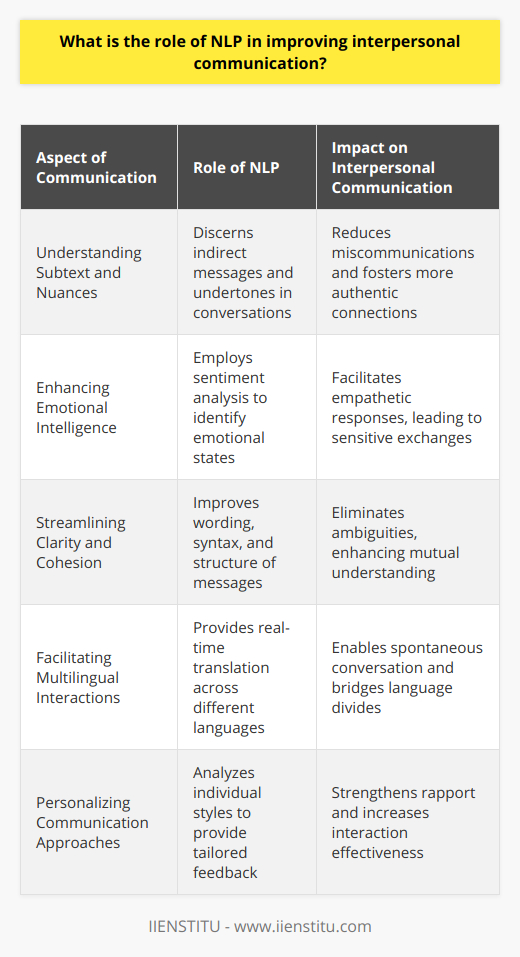
How can the incorporation of NLP techniques enhance the effectiveness of communication?
**Understanding NLP Techniques**
Natural Language Processing (NLP) is a branch of artificial intelligence that focuses on the interaction between humans and computers through natural language. It enables machines to comprehend, interpret, and generate human language in a meaningful manner. The integration of NLP techniques in communication can improve its effectiveness in various ways.
**Enhancing Human-Computer Interaction**
One way NLP can enhance communication is by facilitating a more efficient and natural human-computer interaction, thereby reducing the cognitive load on users. By understanding context and extracting relevant information, NLP-powered tools such as chatbots and virtual assistants can provide more accurate and personalized responses, streamlining communication and ensuring users receive the information they need quickly.
**Improving Sentiment Analysis**
Another area where NLP can improve communication effectiveness is in sentiment analysis. By analyzing text data and determining the sentiment behind it - whether positive, negative, or neutral - NLP can assist businesses in understanding consumer feedback, trends, and preferences. This information can be used to improve products, services, and customer relationships, leading to better communication and overall satisfaction.
**Language Understanding and Translation**
Language barriers are a common challenge in international communication. NLP techniques can help overcome these difficulties by bridging language gaps through automatic translation and interpretation. By eliminating misunderstandings and enabling content to be accessible to a wider audience, NLP supports seamless and efficient communication between individuals who speak different languages.
**Text Summarization and Information Extraction**
In today's information-driven world, it can be difficult to process and synthesize large volumes of text. NLP techniques offer solutions for dealing with this challenge by enabling automatic text summarization and information extraction. With these capabilities, users can quickly grasp the main points of a document or extract essential details without having to read through extensive amounts of text, leading to improved understanding and more effective communication.
**Conclusion**
Through advances in human-computer interaction, sentiment analysis, language understanding, and text summarization, NLP techniques have the potential to significantly enhance the effectiveness of communication. By streamlining interactions, reducing misunderstandings, and facilitating access to relevant information, the incorporation of NLP in communication platforms and tools can lead to increased productivity and a more seamless exchange of ideas and information between individuals and groups.
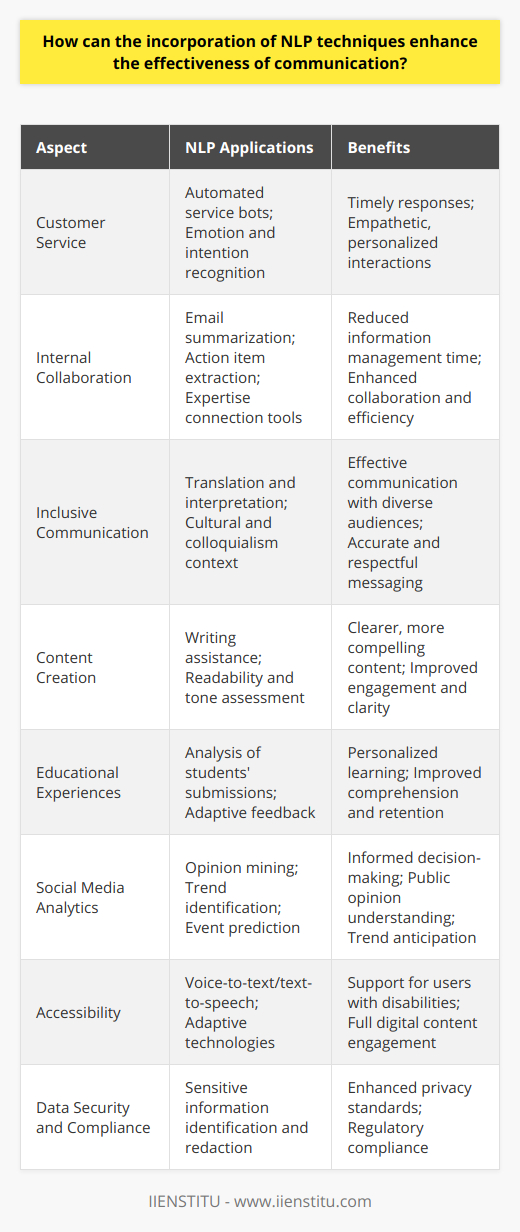
In what ways can mastering NLP techniques contribute to becoming a more proficient communicator?
Enhancing Interpersonal Skills
Mastering NLP (Neuro-Linguistic Programming) techniques significantly contributes to becoming a more proficient communicator by enhancing one's interpersonal skills. NLP emphasizes understanding the intricacies of language, behavior, and thought patterns, enabling individuals to improve their ability to engage effectively in conversations.
Building Rapport with Others
One crucial aspect of effective communication is building rapport with conversational partners. NLP techniques, such as mirroring body language and utilizing matching vocabulary, enable communicators to establish a connection with their interlocutors quickly. This connection fosters trust and understanding, essential components for productive dialogue.
Improving Listening Skills
Effective communication also entails being an attentive listener. NLP techniques focus on honing active listening skills, which involve giving one's full attention to the speaker, acknowledging their thoughts, and providing relevant feedback. By practicing active listening, communicators demonstrate empathy and enhance the quality of their conversations.
Increasing Clarity and Precision
NLP techniques encourage communicators to convey their thoughts clearly and concisely. By refining one's language patterns, communicators can eliminate ambiguity and vagueness, thereby reducing misunderstandings. Additionally, NLP promotes the conscious use of positive language, which facilitates constructive and solution-oriented discussions.
Elevating Persuasive Abilities
Among its many benefits, NLP also cultivates persuasive communication skills. Mastery of NLP techniques enables individuals to tailor their messages according to the preferences, values, and beliefs of their audiences. This customization increases the likelihood of achieving desired outcomes, such as persuading others to adopt a particular viewpoint or take specific actions.
Adapting to Different Communication Styles
Lastly, NLP emphasizes adaptability by equipping communicators with the competence to identify and adjust to various communication styles. This adaptability allows for seamless engagement with diverse individuals, fostering more inclusive and effective interactions.
In conclusion, mastering NLP techniques heavily contributes to becoming a more proficient communicator through improving interpersonal skills, fostering rapport, enhancing listening abilities, increasing clarity and precision, cultivating persuasion, and promoting adaptability. By integrating these techniques into one's communication repertoire, individuals can significantly enhance the quality and effectiveness of their dialogues.
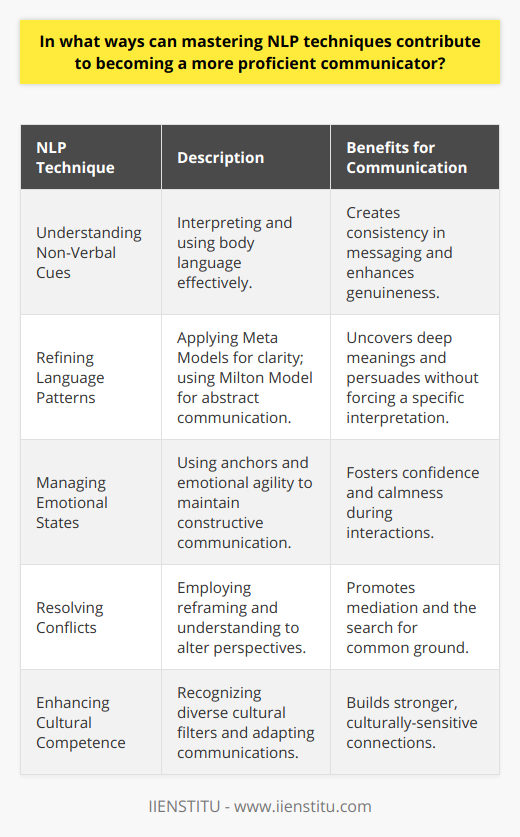
What is the underlying framework of NLP that enables it to facilitate effective communication?
**Underlying Framework of NLP**
The underlying framework of Neuro-Linguistic Programming (NLP) that enables it to facilitate effective communication can be attributed to its core components, which involve modeling, techniques, and presuppositions.
**Modeling the Excellence**
Firstly, NLP draws on the concept of modeling excellence. This approach identifies and replicates the patterns, behaviors, and strategies of successful communicators. By studying these models, individuals can adopt a set of linguistic and behavioral patterns that facilitate an enhanced communication experience.
**Techniques for Efficient Communication**
Secondly, NLP possesses a range of techniques designed to promote effective communication. Among these techniques are rapport-building, reframing, anchoring, and meta-model questioning. These methods allow individuals to navigate and adapt to different communicative scenarios and connect with others on a deeper, more empathic level.
**Presuppositions of NLP**
Lastly, the presuppositions of NLP provide the core belief system that guides the practice. Some of these underlying assumptions include the ideas that everyone has their own unique perception of reality, that every behavior serves a positive purpose, and that non-verbal communication is more significant than verbal communication. These presuppositions foster a flexible and responsive approach to communication, allowing for understanding and appreciation of diverse perspectives.
In conclusion, the underlying framework of NLP enables effective communication by incorporating the principles of modeling, techniques, and presuppositions. By adopting these elements, individuals can improve their communication skills and enhance their connections with others.
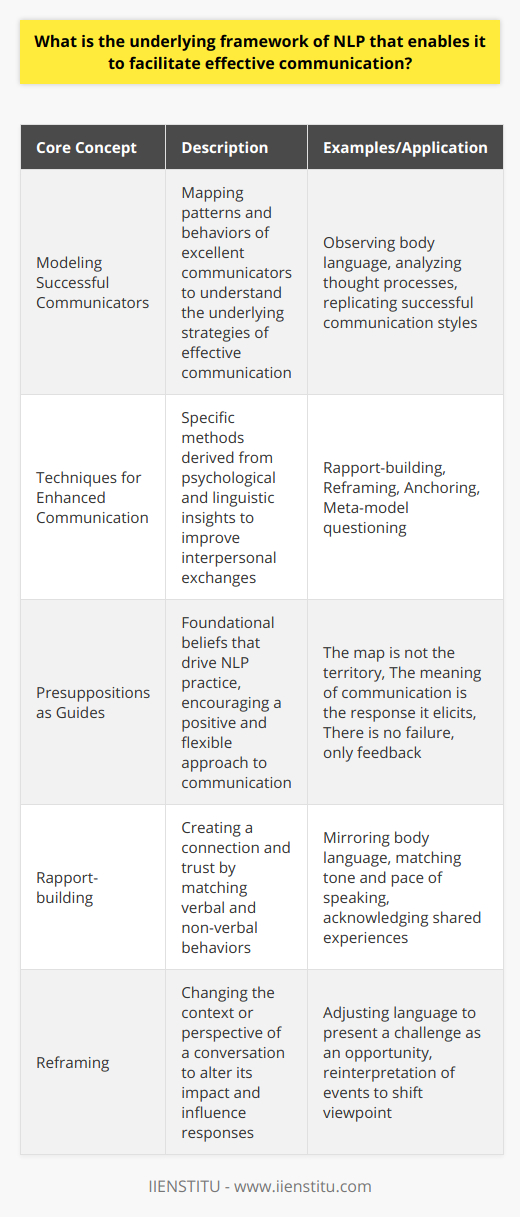
How do NLP techniques specifically aid in overcoming communication barriers and misunderstandings?
**NLP's Role in Enhancing Communication**
Natural Language Processing (NLP) techniques specifically aid in overcoming communication barriers and misunderstandings by facilitating effective interpretation and translation of human language. NLP's advanced algorithms allow computer systems to understand, interpret, and generate human language with high accuracy, making communication clearer and more efficient.
**Reducing Ambiguity**
In written communication, words can often have multiple meanings given their context. NLP offers solutions through its ability to disambiguate sentences and phrases. By analyzing and breaking down sentence structures, NLP can determine the correct meaning, significantly reducing misunderstandings.
**Sentiment Analysis**
Understanding the emotions behind a piece of text is essential in effective communication. NLP implements sentiment analysis techniques to evaluate a text's overall emotional tone. These evaluations can reveal positively, negatively, or neutrally charged sentiments. By assessing these emotions, NLP can offer insights into the intended message, reducing misinterpretations.
**Improving Translation**
Language barriers can hinder effective communication among individuals who speak different languages. NLP's machine translation tools can accurately and promptly translate text, bridging language gaps. By utilizing NLP, cross-cultural communication becomes more accessible, ultimately reducing potential misunderstandings.
**Automatic Summarization**
In an age of information overload, condensing text can enhance comprehension without sacrificing vital content. NLP's extractive and abstractive summarization techniques accurately convey the most important information in a simplified manner, enabling readers to understand key messages efficiently.
**Error Detection and Correction**
Grammar and spelling errors can contribute to unclear communication. NLP algorithms can detect and correct these errors, ensuring that the intended message is conveyed with maximum clarity.
**Customized Conversational Agents**
NLP aids in creating customized conversational agents or chatbots, which can provide focused assistance for specific communication needs. These agents communicate with users using natural language, making the interaction more intuitive and efficient.
In conclusion, NLP techniques play a critical role in overcoming communication barriers and misunderstandings. Through disambiguation, sentiment analysis, translation tools, automated summarization, error detection and correction, and customized conversational agents, NLP helps facilitate effective and clear communication in a world increasingly defined by diverse languages and rapidly evolving technology.

Can the application of NLP techniques in communication help foster stronger relationships, both personally and professionally?
The Potential of NLP in Relationship Building
NLP, or Natural Language Processing, has significantly impacted various fields, including communication. Understanding its applications can improve the quality of the connections we make, both in our personal and professional lives.
Enhancing Self-Awareness
The first step in fostering stronger relationships lies in self-awareness. Utilizing NLP techniques, such as sensory-based language preferences and meta-programs, individuals can identify the unique ways they perceive and process information. This understanding can lead to better communication and stronger bonds with others.
Clarifying Conversational Ambiguity
Ambiguity in communication can pose a significant challenge in building and maintaining strong relationships. NLP techniques offer tools for effectively clarifying ambiguous phrases and discerning the true intentions behind words. Consequently, improving mutual understanding and minimizing potential conflicts.
Matching Communication Styles
People have distinct communication preferences, which can lead to misunderstandings when those preferences differ. Through the application of NLP techniques like mirroring and pacing, individuals can adapt their communication styles to align with those of the people around them, opening up more effective channels of communication and fostering deeper connections.
Developing Empathy and Rapport
Empathy, the ability to step into another person's shoes and understand their emotions, is a crucial skill in relationship building. NLP offers tools such as positive and negative intention reframing to perceive underlying reasons behind behaviors and empathize with others. Furthermore, rapport-building techniques in NLP can help establish trust and make conversations more enjoyable, creating stronger connections.
Resolving Conflicts and Negotiating
Misunderstandings and conflicts are inevitable in any relationship. NLP provides valuable tools for conflict resolution and negotiation, such as perceptual positions, chunking, and outcome specification. These techniques foster collaborative problem-solving, promoting a positive outcome and strengthening both personal and professional relationships.
In conclusion, the application of NLP techniques has immense potential in improving communication and fostering stronger relationships, both personally and professionally. By enhancing self-awareness, clarifying conversational ambiguity, matching communication styles, developing empathy and rapport, and providing conflict resolution tools, NLP can significantly contribute to the improvement of the quality of our connections with others.
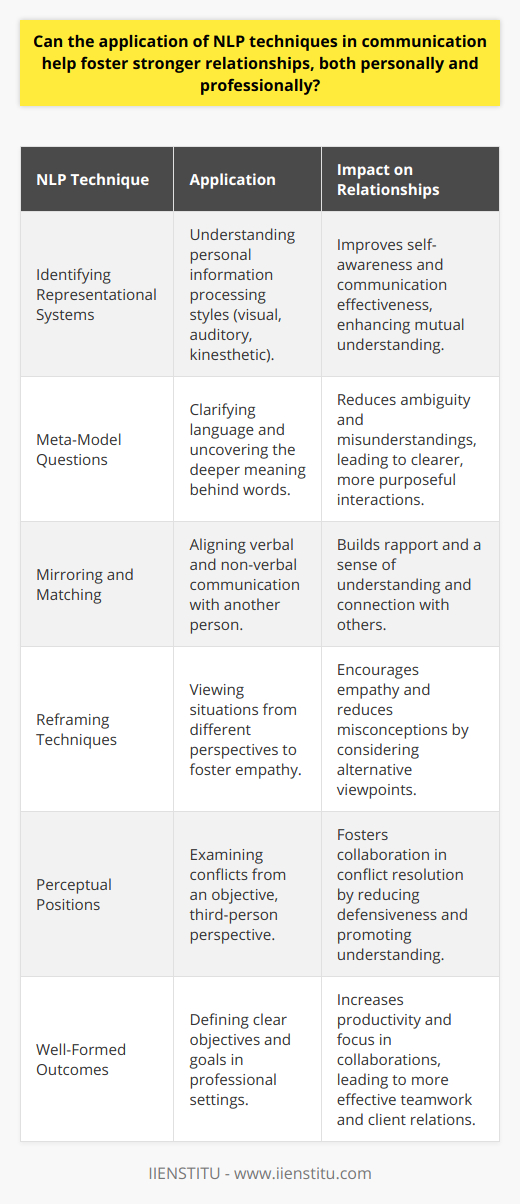
Which techniques can one use in order to become a good communicator?
Developing Active Listening Skills
One of the most vital techniques to become a good communicator is developing active listening skills. Active listening involves full concentration on the speaker, asking relevant questions, and giving feedback, which helps to ensure complete understanding of the message being conveyed. By doing so, a two-way communication environment is established, enabling both the speaker and the listener to effectively exchange ideas and better address concerns.
Understanding Nonverbal Communication
Another essential element in effective communication is the ability to interpret and utilize nonverbal cues. Nonverbal communication includes body language, facial expressions, and gestures that often convey messages more profoundly than words. Being aware of such signals can significantly enhance the communication process, as it enables individuals to gauge the emotions, attitudes, and reactions of others, thereby allowing for appropriate responses and adjustments in communication strategies.
Embracing Empathy
Cultivating empathy is a critical aspect of becoming a good communicator. Empathy requires an individual to put themselves in the shoes of the person they are communicating with, enabling a deeper understanding of their circumstances, feelings, and motivations. By doing this, the communicator can better tailor their messages and explanations to meet the needs of their audience, thereby fostering effective communication and establishing a stronger connection.
Utilizing Clarity in Speech and Writing
Good communicators ensure that their speech and writing are concise and unambiguous. This involves using simple, straightforward language, delivering information in an organized manner, and avoiding jargon or overly complex terms that may alienate listeners or readers. Clarity enables the effective transmission of ideas and reduces the likelihood of misunderstandings, facilitating smooth communication between parties.
Adapting to Different Communication Contexts
Lastly, learning to adapt communication styles to suit varying contexts and audiences is crucial in becoming a good communicator. This entails paying attention to language, tone, and content that best fit a given situation or the needs of an audience. Being able to adjust one's communication accordingly not only enhances the overall effectiveness of the message being delivered but also helps to establish rapport and trust.
In conclusion, by developing active listening skills, understanding nonverbal communication, embracing empathy, striving for clarity, and learning to adapt to different contexts, one can substantially improve their communication skills and become a more effective communicator.
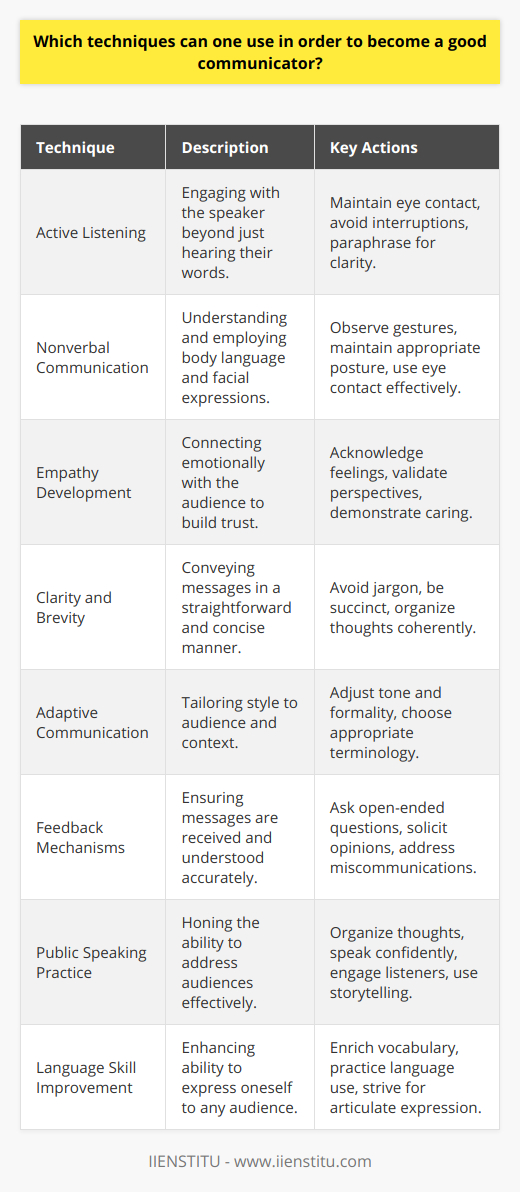
How can NLP be utilized to develop empathy and rapport in communication?
Developing Empathy with NLP Techniques
One significant utilization of natural language processing (NLP) in enhancing communication is fostering empathy and rapport among conversation partners. By accurately interpreting, understanding and responding to emotion in text, NLP can bridge the gap between digital communication and human emotion. For example, sentiment analysis, an NLP technique, can gauge the emotion behind a message and classify it into categories, such as positive, negative, or neutral. This information can help anticipate the concerns and feelings of communication partners.
Role of Emotion Recognition
Emotion recognition is a crucial factor in building empathy and rapport. Expanding beyond basic sentiment analysis, NLP can identify nuanced emotions within the text by analyzing syntax and word choice. Advanced NLP models, such as GPT-3, are designed in a way that they can even predict emotion based on context, making it even more powerful in developing empathy through linguistic understanding.
Utilizing Chatbots for Emotional Support
A practical application of NLP tools in developing empathy and rapport can be seen in the building of emotionally intelligent chatbots. These conversational agents can provide emotional support and assistance by recognizing the user's emotional state, offering empathetic responses, and evolving the conversation based on the user's needs. This capability enables emotionally supportive interactions to increasingly closer to human-like exchanges through intelligent and empathetic textual responses.
Enhancing Communication in Customer Support
In customer support, empathetic communication is vital for successful resolutions and building strong relationships with clients. NLP tools can analyze customer messages, detect emotional trends, and provide insights for support agents on how to better empathize with customer concerns. These insights enable agents to address the client's emotions effectively, leading to more productive conversations and stronger rapport between customers and support agents.
Improving Collaborative Environments
Similarly, in collaborative environments, NLP can be used to detect emotions and conflicts among team members, paving the way for early interventions and effective resolutions. For instance, it can be used to mediate communication patterns by providing different team members with insights on the emotional dynamics within the group. Consequently, this understanding can help improve team cohesion, rapport, and productivity.
In conclusion, NLP techniques can be effectively utilized to develop empathy and rapport in communication, fostering more positive and productive exchanges across various domains, including customer support, collaborative environments, and even mental health support systems. The crucial aspect is understanding and processing emotions in text, which can enhance human-human and human-machine interactions.

Are there any limitations or potential pitfalls of relying solely on NLP for effective communication?
Limitations of Relying Solely on NLP
Lack of Nonverbal Cues
One limitation of relying solely on Natural Language Processing (NLP) for effective communication is the absence of nonverbal cues. Nonverbal cues, such as facial expressions, body language, gestures, and tone of voice, play a crucial role in conveying meaning and intent. NLP, which focuses on processing and understanding text, does not account for these important aspects of human communication.
Misinterpretation of Ambiguity
Another potential pitfall in relying solely on NLP is misinterpretation due to ambiguity. Language is inherently ambiguous, with many phrases and sentences having multiple possible interpretations. NLP often struggles to discern the intended meaning in these cases. Consequently, misunderstandings may arise, leading to communication breakdowns.
Difficulties in Processing Idiomatic Expressions
NLP also faces challenges in processing idiomatic expressions, slang, and regional language variations. Idioms and slang expressions are deeply rooted in culture and can have meanings different from their literal interpretation. Ineffective processing of such expressions may result in an inaccurate representation of the intended message.
Limited Understanding of Context
The limited understanding of context is another drawback of depending solely on NLP for communication. NLP algorithms may struggle to accurately interpret certain phrases or statements without adequate contextual information. For example, the same word may have different meanings depending on the context it is used in. Without proper comprehension of the context, it is difficult for NLP algorithms to understand the intended meaning behind the words.
Lack of Emotional Intelligence
An additional limitation of NLP is the lack of emotional intelligence, which is essential for effective communication. While NLP algorithms are exceptional at analyzing word patterns and frequency, they are not yet capable of understanding complex human emotions fully. As a result, NLP technology may misinterpret the emotional intent behind a message, leading to misunderstandings.
In conclusion, there are several limitations and potential pitfalls in relying solely on NLP for effective communication. Missing nonverbal cues, misinterpretation of ambiguity, difficulties in processing idiomatic expressions, limited understanding of context, and the lack of emotional intelligence hinder NLP's capability to fully comprehend and convey human communication. As NLP technology continues to evolve, however, it is expected to improve and become more adept at overcoming these challenges.
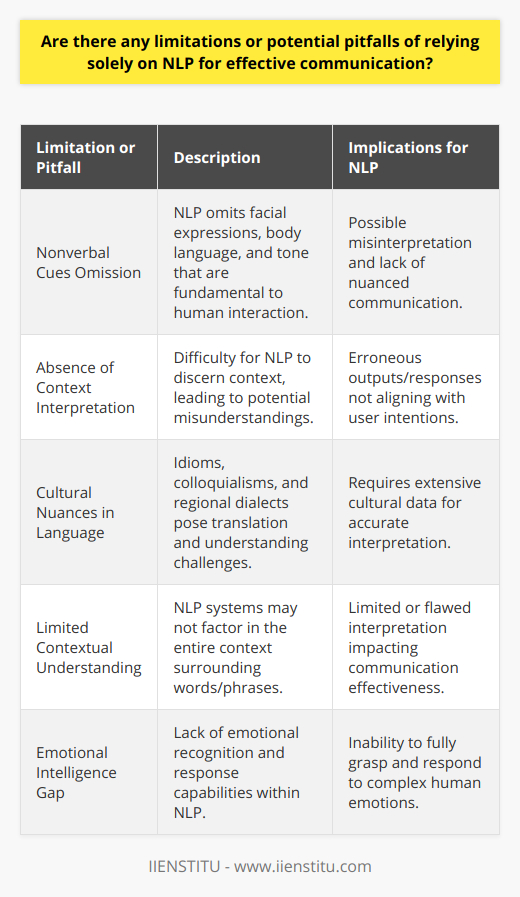
What is the best NLP technique for enhancing emotional intelligence and self-awareness?
**Introduction to NLP and Emotional Intelligence**
Natural Language Processing (NLP) refers to the utilization of artificial intelligence to understand and process human language. Emotional Intelligence (EI), on the other hand, involves the awareness and management of emotions by individuals. NLP techniques extend to various fields, including enhancing emotional intelligence and self-awareness.
**Sentiment Analysis for Emotion Recognition**
The most promising NLP technique for enhancing emotional intelligence and self-awareness is Sentiment Analysis. This method focuses on extracting and interpreting subjective information from textual data, assisting individuals in recognizing their own emotions and assessing others'.
**Textual Analysis for Self-reflection**
Moreover, NLP can facilitate self-awareness through textual analysis of personal writing. By extracting and contextualizing insights, individuals gain a more profound understanding of their emotions, intentions, and communication styles. As a result, self-awareness and emotional intelligence improve.
**Dialog Systems for Interpersonal Skill Development**
Dialog systems, such as chatbots, provide a safe and controlled environment for individuals to practice emotional intelligence and self-awareness. Interaction with a conversational agent allows for honest self-examination and real-time feedback on communication skills.
**Behavioral Modeling through Language**
NLP can also improve emotional intelligence by analyzing behavioral patterns communicated in spoken or written language. Identifying and reflecting on these patterns enable individuals to modify and adjust interpersonal skills accordingly.
**Conclusion: Leveraging NLP for Emotional Growth**
In summary, NLP offers various techniques for enhancing emotional intelligence and self-awareness. Sentiment analysis, textual analysis, dialog systems, and behavioral modeling through language can all contribute to growth in emotional intelligence, ultimately leading to improved communication, empathy, and interpersonal skills.
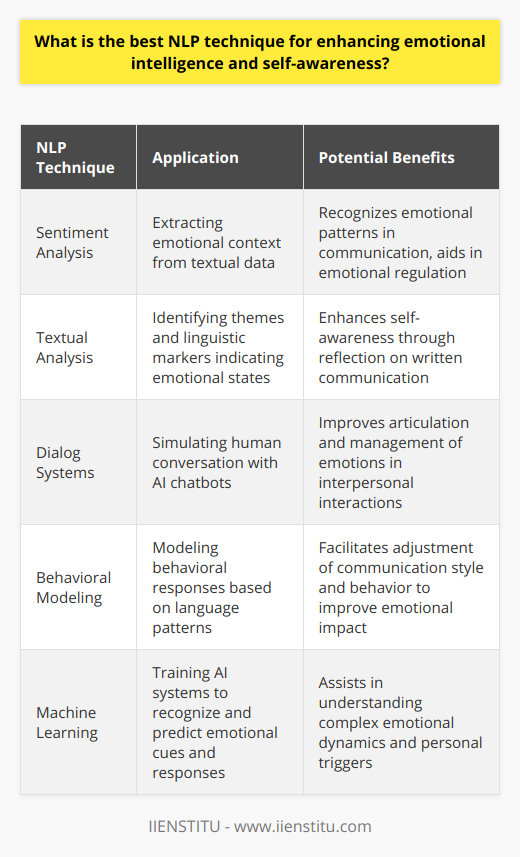
How can NLP impact effective communication in various cultural contexts and across different personality types?
Cultural Contexts and NLP
One way in which natural language processing (NLP) can impact effective communication across cultural contexts is by fostering mutual understanding. NLP algorithms can analyze and interpret linguistic cues within a conversation, detecting differences in communication styles that are typical of various cultures. By identifying these nuances, NLP tools can facilitate accurate translation between languages, thus reducing misunderstandings in cross-cultural communication.
Overcoming Language Barriers
Another area where NLP plays a crucial role is in overcoming language barriers. NLP techniques, such as machine translation and language models, can provide real-time translations for speakers of different languages. This allows individuals to communicate confidently in global settings, such as international conferences or multinational business environments, without struggling with language fluency.
Personality Types and NLP
In terms of personality types, NLP can help customize communication strategies to better resonate with the recipient. By analyzing written or spoken language, NLP can identify keywords, phrases, or patterns that indicate a person's preferred communication style, such as highly analytical or more emotionally expressive. Armed with this information, communicators can tailor their messaging to enhance the reception and comprehension of their intended audience.
Building Rapport and Empathy
NLP tools can also assist in building rapport and empathy between communicators, despite differences in personality types. By generating suggestions for appropriate responses or offering insights into the subtle, unspoken cues that underlie a conversation, NLP can enhance one's ability to construct meaningful and empathetic interactions. This, in turn, can contribute to more effective communication across various personality types.
In conclusion, NLP has the potential to significantly improve effective communication in different cultural contexts and across diverse personality types. By enabling more accurate translations, identifying individual communication styles, and fostering rapport and empathy, NLP ultimately supports more successful and harmonious interactions.
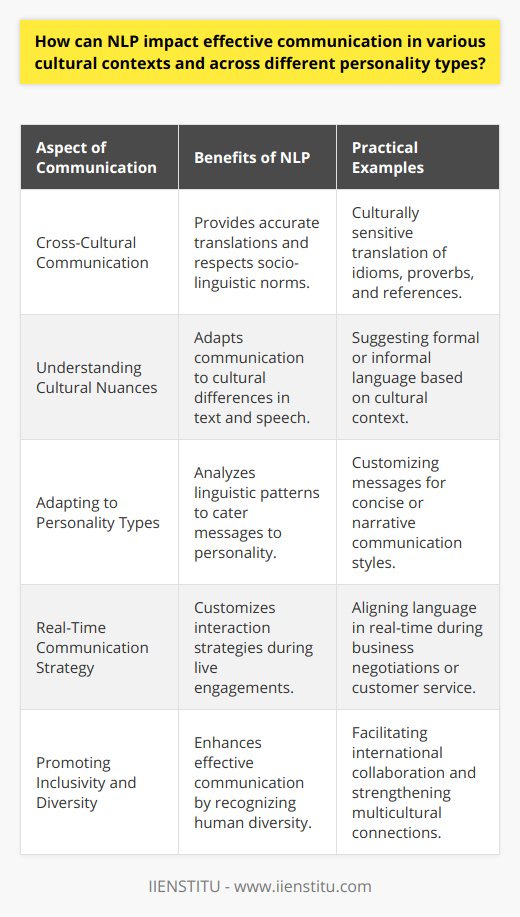
What are the NLP techniques for decision making in high-pressure situations, and how can their application lead to better outcomes?
NLP Techniques for Decision Making
Natural Language Processing (NLP) techniques can significantly improve decision-making in high-pressure situations by facilitating enhanced communication, understanding, and emotional control. In such scenarios, critical decisions are influenced by the individual's ability to manage thoughts, feelings, and behaviours effectively.
Active Listening and Empathy
Active listening and empathy are two NLP techniques that enable better communication, allowing individuals to better evaluate their options during decision-making. By attentively listening to others and understanding their perspectives, individuals can make more informed and well-rounded decisions.
Rapport Building
Establishing a strong rapport with others is another essential NLP technique for decision making in high-pressure situations. Through rapport building, individuals can create a supportive environment where trust and collaboration are heightened, leading to increased morale and better decision-making.
Reframing and Cognitive Restructuring
Reframing and cognitive restructuring help individuals reevaluate their thinking patterns and mental models in high-pressure situations. By identifying and replacing negative thought patterns with more rational and positive ones, individuals can better navigate difficult circumstances and make more effective decisions.
Anchoring and Emotional Control
Anchoring is an NLP technique that fosters emotional control, thereby enhancing decision making in high-pressure situations. This process involves associating specific positive states with physical cues to manage emotions effectively and respond to stress with clarity and understanding.
Outcome Framing
Focusing on the desired outcome rather than the problem is a powerful NLP technique to enhance decision making in high-pressure situations. By switching the focus from the obstacles to the end objective, individuals can maintain motivation, stay solution-oriented, and make better decisions.
Considering Multiple Perspectives
NLP encourages the consideration of multiple perspectives when making decisions in stressful situations. By exploring different points of view, individuals can gain a comprehensive understanding of a problem and create innovative solutions that may not have been initially apparent.
In conclusion, the application of NLP techniques in decision-making can lead to better outcomes by fostering improved communication, understanding, and emotional control in high-pressure situations. These practices allow individuals to navigate challenging circumstances effectively, ensuring the formulation of well-informed and beneficial decisions.
